
Globalizing Hegemony and Resistance:
Words and Images of Terror and Protest
Francis A. Beer
G. R. Boynton
Globalizing Hegemony and Resistance
In the 21st century, the United States has adopted globalization as a major policy. Global institutions like the International Monetary Fund, the World Bank, and the World Trade Organization advance a global agenda. More partial groupings, like the G-7 and G-8 (Heads of State from Britain, Canada, France, Germany, Italy, Japan, Russia, and the United States) have also moved this agenda forward.Such globalization has different political, economic, social, cultural, and scientific dimensions. Globalizing policies and processes have variable impacts and activate different responses from actors in different parts of the world. Some of the responses support hegemony, while others bolster local resistance (cf. Chomsky, 2003; Hoffmann, 2002; Joseph, 2002; Weber, 1999; Keohane, 1984).
There is solid reasoning behind globalization. Economic theory, for example, suggests that free trade brings economies of scale and efficiencies of specialization. At the same time, globalization can bring distortions and dislocations. It also carries unequal costs and benefits for different political groups, social classes, and geograpahical areas. These issues are not only discussed and negotiated in boardrooms and academic journals. They have very real implications for the lives of individuals in more local communities. And these people have ways of making their views heard.
One way that this occurs is through the media, which are also globalizing and creating their own sectoral tendencies and contributions toward hegemony and resistance (cf. Tehranian, 1999; Taylor, 1997; Comor, 1994). CNN Worldview, during the period of our study, carried reports of economic protests at a series of economic meetings of the G-7, later the G-8. The political leaders at the G-7 and G-8 meetings used the media to project hegemonizing images of power and purpose. At the same time, protesters against economic globalization used the global media network to make their points and convey their own messages. The demonstrations provided the media with exciting visual images—colorful people, engaged in collective action, with police opposition and sometimes violent clashes. Protesters were able to use local actions to make global points and reach a global audience. Media reporting included both protesters and protestees, and the media reports generated sympathy for both groups (see also Shaw, 1996). They also strengthened the globalizing and hegemonic tendencies of the media that carried their messages.
Stories of Resistance
The presentation centers on the way that global news media tell the story of resistance, using words and images of protest and terror. The emergence of global news broadcasting has opened an expanding global media domain and a new theater for political agents and political action. Our presentation examines the extent and variety of reports of political protest and terror in this new global media domain. We have recorded global news broadcasts during the following years: 1998-2000 of CNN's WorldView and 2001-03 of BBC's World News. In this presentation, we report the frequency of news stories about political protest and terror. Focusing on half a dozen specific episodes (Kosovo, Israel-Palestine, US-Iraq twice, the activity of al Qaeda and Afghanistan), we analyze the words and images used to describe protest and terror. Finally, we draw conclusions about the implications of these media reports for the psychology of protest and terror, political hegemony and resistance, and the emerging global communication regime (see also Beer and Boynton, 2004).
Categories of Resistance
If one operates with a general category of resistance then protest and terrorism may both be types within that general category. The question is how are these things presented in the media. In the media they are presented independently. 'Resistance' is in 158 stories. 'Resistance' and (terrorist or terrorism or terror)are in 26 of those 158 stories. 'Resistance' and 'protest' are in 16 of the 158 stories. To tell us a story about resistance normally does not overlap with telling us a story about either protest or terrorism. If they were giving it to us as a general category with specific instantiation then one would expect more overlapping of the words in the stories. A further complication: there is not large overlap between terrorist, terrorism and terror. The counts are: terrorism and terror 60; terrorist and terror 70; terror 206 [by itself];terrorist 717 [by itself]; terrorism 521 [by itself].So we have a whole 'slew' of words that seem related, but which are only used together in a minority of stories. The intersections are relatively small.
Resistance Reports and Events
Figure 1 shows the number of media reports of protest, demonstration, and terror per day over the period covered by the study, 1998-2002. The frequencies derive from an initial search for news stories that have the designated words in them, followed by division by the number of broadcasts for per 6 month time interval. The frequencies of stories about protest and demonstration remain relatively stable over the whole period, except for a temporary spike in the first half of 2001. Reports of terrorism rise in the second half of 2001 with the attacks of 9/11 and then come down, but not to the original baseline level. It is interesting to compare this pattern with Figure 2, which outlines the actual frequency of terrorist attacks themselves from 1998-2003. There is a long term secular decline in attacks, which includes a temporary rise in 1999 and 2000, and then a subsequent fall. These data celearly show that the frequency of media reports on aspects of resistance do not exactly track of the incidents themselves. Obviously the attacks of 9/11 and the subsequent War on Terror activated the media to increase their reporting of terrorism. The event itself was of major importance, and stimulated political and media elites to greater efforts, reflected by more words and actions. Perhaps this heightened concern had an independent repressive effect on terrorism; perhaps it simply added to prior efforts that had been gradually reducing terrorism; perhaps other factors, including reporting anomalies, contributed to the reported long term decline in terrorist incidents.
Figure 1
Frequencies of Protest, Demonstration, and Terrorist Stories
 |
Figure 2
Frequency of Iternational Terrorist Attacks
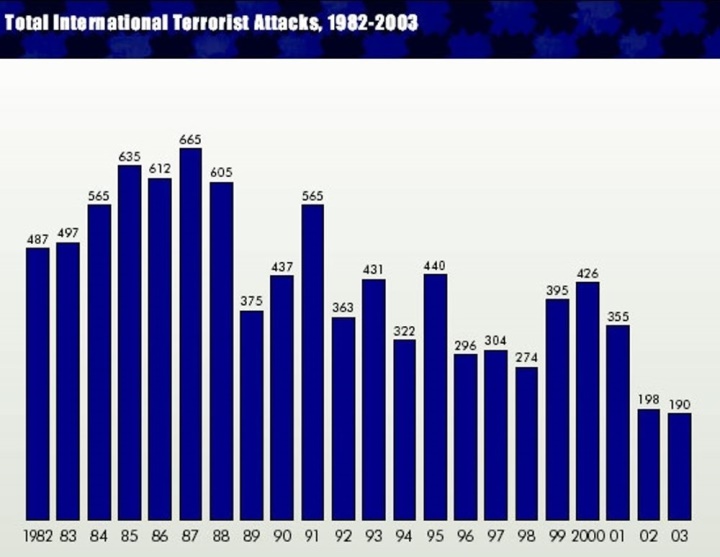 |
The Psychodrama of Hegemony and Resistance
The categories and frequencies of these global reports and events only scratch the surface of the stories. Beneath the statistics lies the video theater of hegemony and resistance. In this psychodrama, following Greek aesthetics of prosopopoiea, stock characters personify larger forces. These characters carry standard masks, costumes, and props (cf. Herrmann, et al.,1997; Hurwitz, 1989; Cohen, 1987; Walker, 1987).
The Hegemon
The first character is the Hegemon, who embodies the state's monopoly of violence and carries the mask of command (Keegan, 1987). The President of the United States is the principal character who appears in this role on the world's television stage. Sometimes he plays it alone; sometimes he is accompanied by a supporting cast that may include political leaders from major nation states (Britain, Canada, China, France, Germany, Japan, Russia) international alliances (NATO), or other major international organizations (the United Nations or the European Union). In the first image below, we see U.S. President Bill Clinton, supported by British Prime Minister Tony Blair, assume the mask, the costume, and the props of the Hegemon. The Hegemon brothers are serious and unsmiling middle aged men, shaved close and clean; their hair is cut short. They wear dark suits, white shirts, and conservative ties. Behind them are white columns (probably faux) and red carpet. Before them are papers (probably the text of speeches). Beside them are the strongest symbols of their hegemonic power, the flags of their nations. The hegemons represent their peoples, articulating the voices of the mute masses. They have speaking parts as talking heads with occasionally supporting bodies. They personify power, they articulate power, they are power, on the world stage. They are the global Hegemons.
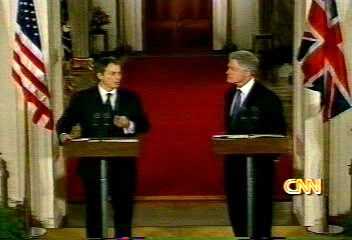 |
The Hegemons have much to say to the other actors on
the world stage, and to the audience. One of the most important part of their script
is to define the Resisters. 
In the video clip to the right, U. S. President George W. Bush plays the Hegemon. Again he wears the Hegemon costume--dark suit, white tie. His hair is cropped close; he is clean shaven. He speaks in short sentences, using short words. His rhetoric is clear and powerful as he sells the hegemonic script, tarring a broad range of resistance actors and activities with the terrorist brush.
The Resister
Different characters appear as Resisters, who challenge the global Hegemon's legitimacy and monoply of violence. Some Resisters are hard to distinguish from the Hegemons. Slobodan Milosevic is an example from this set. His costume does not identify him as a Resister. We only know that he is a Resister from his rhetoric, which contests the legitimacy of the trial which he is forced to endure.
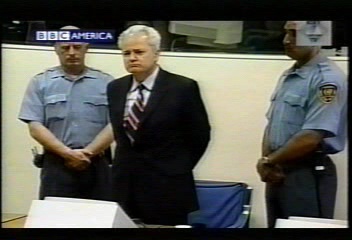 |
Other Resisters carry very different masks, costumes, and props. One set of such political leaders includes figures such as Osama Bin Laden, Yasir Arafat, and FidelCastro. The picture of Osama bin Laden below, for example, also shows a serious, unsmiling man. He is, however, dark skinned (cf. Entman and Rojecki, 2001; Shaheen, 2001, Parenti, 1992). Unlike the Hegemon, he has a beard. He wears no tie, but an ethnic headdress and military combat fatigues. There is a microphone for him to speak. Between him and the microphone there may be a rifle. He is an important type of Resister.
 |
The Chorus
The Chorus appears, not individually, but collectively. It includes both a civilan and a military cohort. The London demonstrators immediately below, the "voices of dissent," embody the civilian chorus in a crowd scene. There are men, women, and children with different hair and clothes. They do not speak publically, except, perhaps, to chant slogans like "give peace a chance." They carry banners and signs to be read by others. Part of their intended audience is local--Tony Blair in London or Silvio Berlusconi in Rome. Another part is global. They want the world--and particularly the big Hegemon, George W. Bush--to see and hear. In spite of local language differences, the signs are often in English for the English-speaking audiences of global television. Resisters write English; English is the language of the Hegemon.
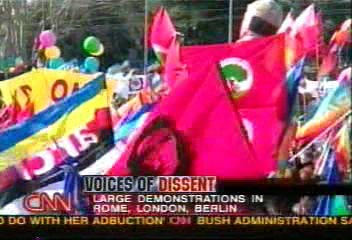 |
There is also a military chorus, which consists of fighters. These fighters can be part of either the Resister or the Hegemon camp. Both groups appear in the Genoa streetfighting scene below, a moving tableau of Resisters v. Hegemons. One way to tell which team they are on is by their costumes and props. Resisters wear "anarchist T-shirts" and scruffy clothes; they throw random objects like paving stones. The Hegemons are the ones with helmets and uniforms. The Hegemons also use tear gas, water cannon, and fences.
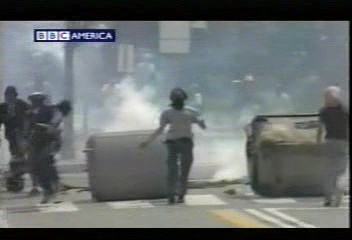 |
The videos below first show "terrorist" "ethic Albanian gunmen from from the Kosova Liberation Army. When the fighters start as Resisters, they have no standard costume. When they are later recognized by the Hegemon, they are pictured with government issue uniforms.
 |
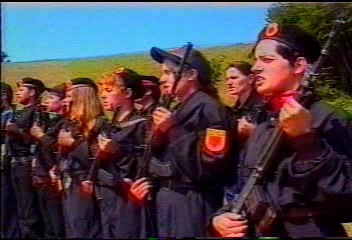 |
|
Before
|
After
|
The pictures below who the Northern Alliance in Afghanistan. In its initial Resister phase, it is "a disparate force made up of various ethnic groups and with refugrees and children in its ranks" that "seems to exist in a different military age." After adoption by the Hegemon, it achieves a more regular media status as the troops line up and salute smartly.
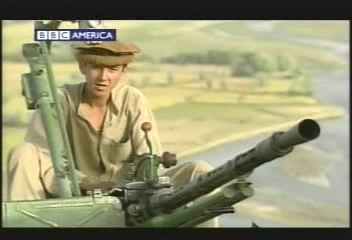 |
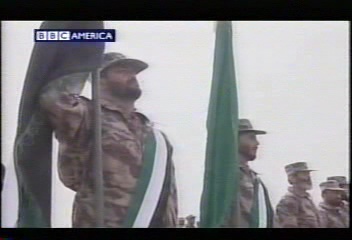 |
|
Before
|
After
|
The Global Political Media Spectacle
Global news reflects and constructs the continuing story and structure of global hegemony and resistance, a television serial with a simple formula that keeps the audience coming back for more. Words and images of terror and protest are crucial elements of this story. In the play, hegemons and resisters have different masks, costumes, and props. Some characters speak and others don't. In any case, one learns little of what goes on behind the political media spectacle (Edelman, 2001). Hegemons and resisters, protesters and terrororists, are simple free-floating figures that close discourse rather than open it, hardly reflecting the complexity and ambiguity from which they are plucked.. What one learns about are the masks, costumes, and props. There are scripted reports of actions and events; standard speeches with formulaic rhetoric. One never looks behind the mask to the actors; one does not go backstage. More concretely, one learns about the acts; one does not learn about the persons and why they engage in these acts. The story of hegemony and resistance dehumanizes the actors so that they can perform their stylized roles in blocky action sequences and the play may go on.
The global theater of the news has its own logic of expansion and production. Globalization generates discontent. Yet, even as people resist globalization, they use and expand it. The global media provide the virtual stage on which the resisters perform. As they use this stage, the resisters, paradoxically, provide the content which helps globalization to grow. The resisters energize global stories with dramatic words and images. They provide vicarious thrills and chills as they feed the media’s need for excitement. They are an essential element of the basic conflict plot that attracts audiences and advertisers, and on which the media depend. Hegemony and resistance, in order to be effective, become an element of the global political media spectacle. Economically, Hegemons and Resisters lower media costs by gripping programming with free production to the global networks. There is no need to pay large sums to professional performing artists, making believe. The real thing is provided for only the price of a cameraman.
The spectacle is driven by political, military, economic, social, cultural, and technological forces. It also feeds on a rich psychological energy. Writers from Aristotle to Kenneth Burke have reminded us of the importance of drama for our collective psychological life. Drama is a way in which we perceive and interpret the world, including the world of politics. The modern news media draw from and contribute to this tradition. Most of the psychology of the drama thus takes place not on the screen, but in the minds and hearts of the audience. Video news stories, with their stock characters and plots, help modern citizens understand politics cognitively and emotionally. The audience feels shock and awe, pity and fear, shame and guilt, sorrow and satisfaction, attaction and and revulsion, the joy of victory and the agony of defeat. As they identify and connect emotionally with the characters, they merge with the Hegemon, the Resister, and the Chorus to become actors themselves in the public space. Dramatic tensions keep them connected, and they become stakeholders. Political, military, economic, social, cultural, and technological elites have an interest in the audience staying in and at the edge of their seats. At the same time, no matter how high the media raise the excitement level in the roller coaster, cathartic resolution is never far away. And then, after the satisfying end of one story, comes the beginning of the next episode. The spectacle, with its dramatistic psychology, continues. The media myth factory nourishes the common narratives on the field of dreams. It projects onto the screen of our minds the images, through which we understand the political world, that help to organize our political lives.
References
Beer, Francis A. and G. Robert Boynton. 2004. “Globalizing Terror,” POROI Journal 2, 1 (http://inpress.lib.uiowa.edu/poroi/papers/beer030725_outline.html .
Chomsky, Noam. 2003. Hegemony or Survival: America's Quest for Global Dominance. The American Empire Project. New York: Metropolitan Books, 2003.
Cohen, Raymond. 1987. Theater of Power: The Art of Diplomatic Signalling. London: Longman.
Comor, Edward. A. 1994.The Global Political Economy of Communication: Hegemony, Telecommunication, and the Information Economy. New York: St. Martin's Press, 1994.Edelman, Murray J. 2001. The Politics of Misinformation. Cambridge, UK ; New York : Cambridge University Press.
Entman, Robert M. and Andrew Rojecki. 2001. The Black Image in the White Mind: Media and Race in America. Chicago : University of Chicago Press.
Herrmann, Richard K., James F. Voss, T. Y. E. Schooler, and J. Ciarrochi. 1997. "Images in International Relations: An Experimental Test of Cognitive Schemata. International Studies Quarterly, 41, 403-433.Hoffmann, Stanley. 2002. “Clash of Globalizations,” Foreign Affairs 81, 4: 104-116.
Hurwitz, Roger. 1989. in James Der Derian and Michael J. Shapiro, International/Intertextual Relations. Lexington MA: Lexington.
Joseph, Jonathan. 2002. Hegemony: A Realist Analysis. London, New York : Routledge.Keegan, John. The Mask of Command. New York: Viking, 1987..
Keohane, Robert O. 1984. After Hegemony: Cooperation and Discord in the World Political Economy. Princeton, N.J.: Princeton University Press.
Parenti, Michael. 1992. Make-Believe Media: Politics of Entertainment. New York: St. Martins Press.
Shaheen, Jack J. 2001. Reel Bad Arabs: How Hollywood Vilifies a People. Interlink.
Shaw, Martin. 1996.Civil Society and Media in Global Crises: Representing Distant Violence. New York: Pinter.
Taylor, Philip. M. 1997. Global Communications, International Affairs, and the Media since 1945. London UK: Routledge.
Tehranian, Majid. 1999. Global Communication and World Politics: Domination, Development, and Discourse. Boulder CO: Lynne Rienner.
U.S. Department of State. 2004."Patterns of Global Terrorism." Released by the Office of the Coordinator for Counterterrorism. http://www.state.gov/s/ct/rls/pgtrpt/2003/31751.htm
Walker, Stephen G., ed. 1989. Role Theory and Foreign Policy Analysis. Durham NC: Duke University Press.
Weber, Cynthia. 1999. Faking It: U.S. Hegemony in a "Post-Phallic" Era. Minneapolis: University of Minnesota Press.